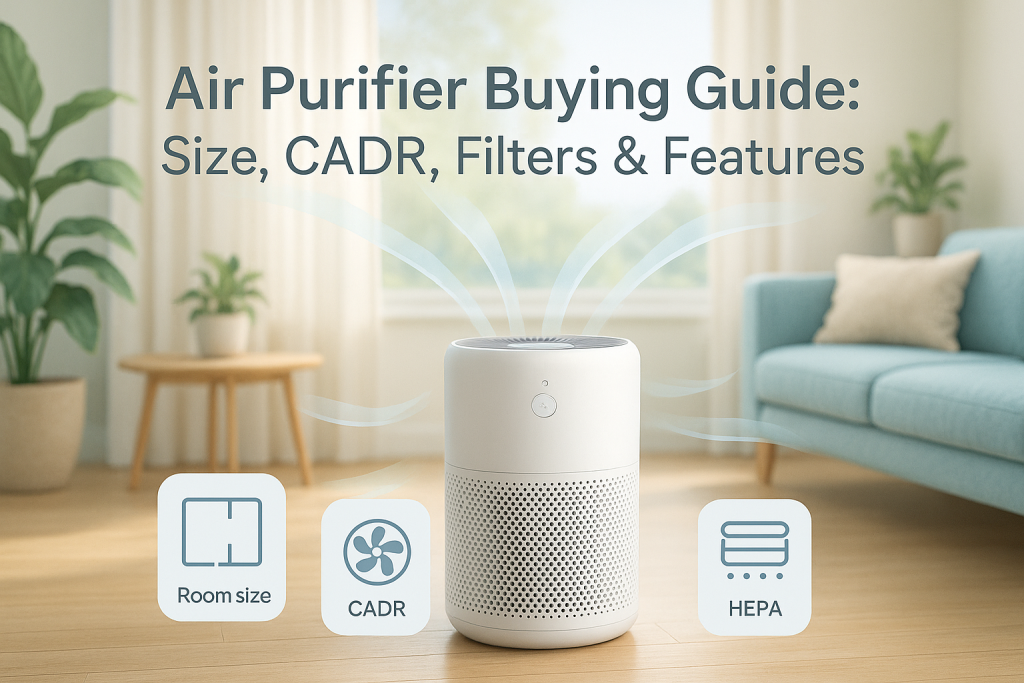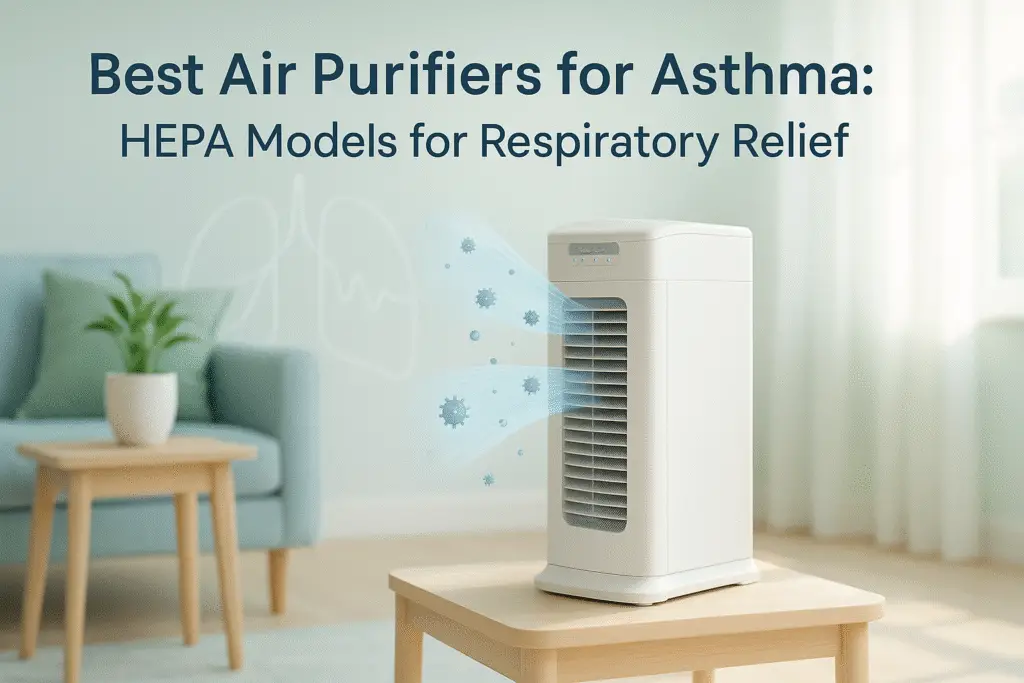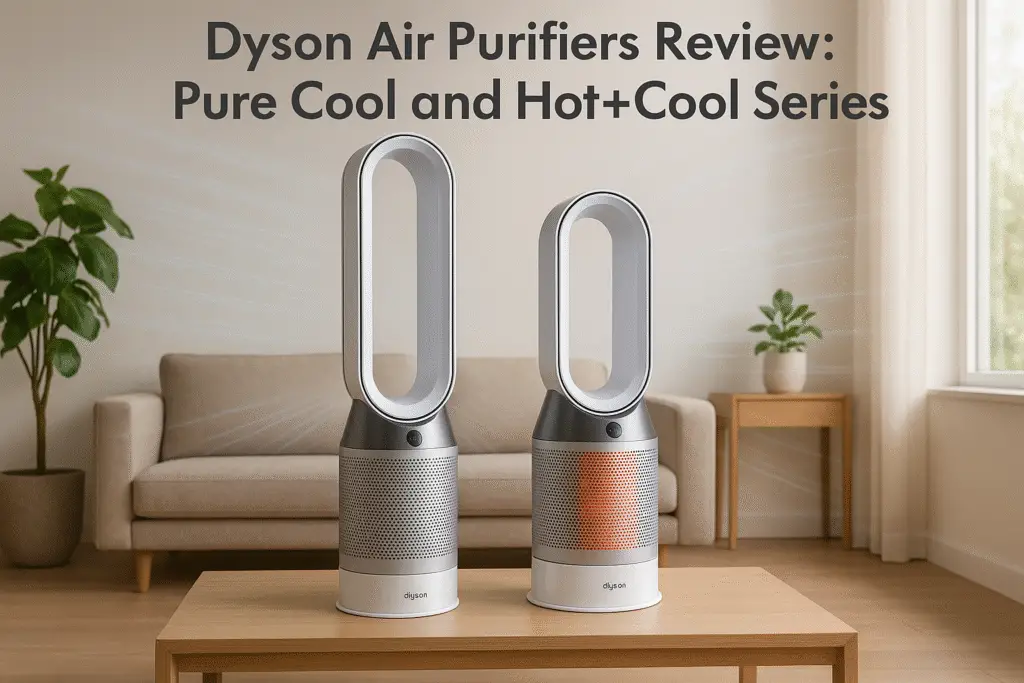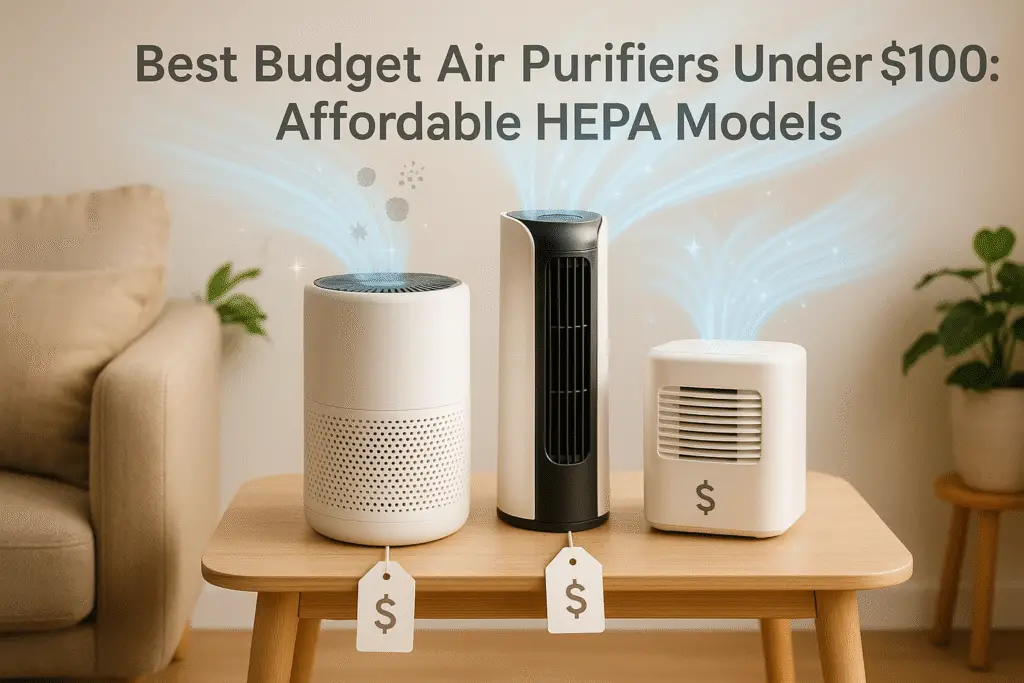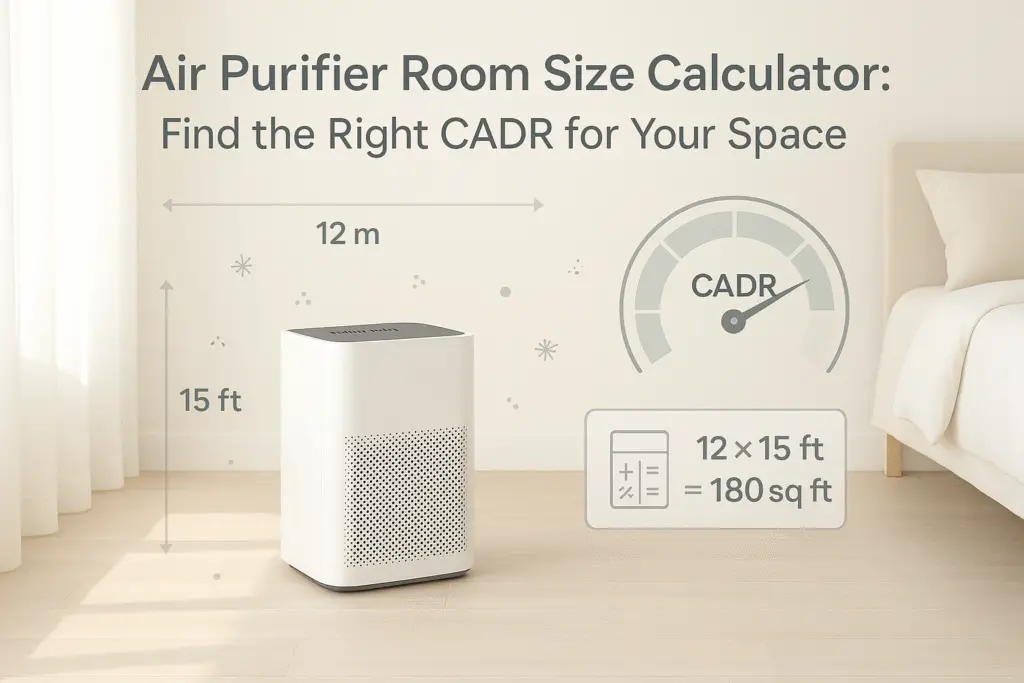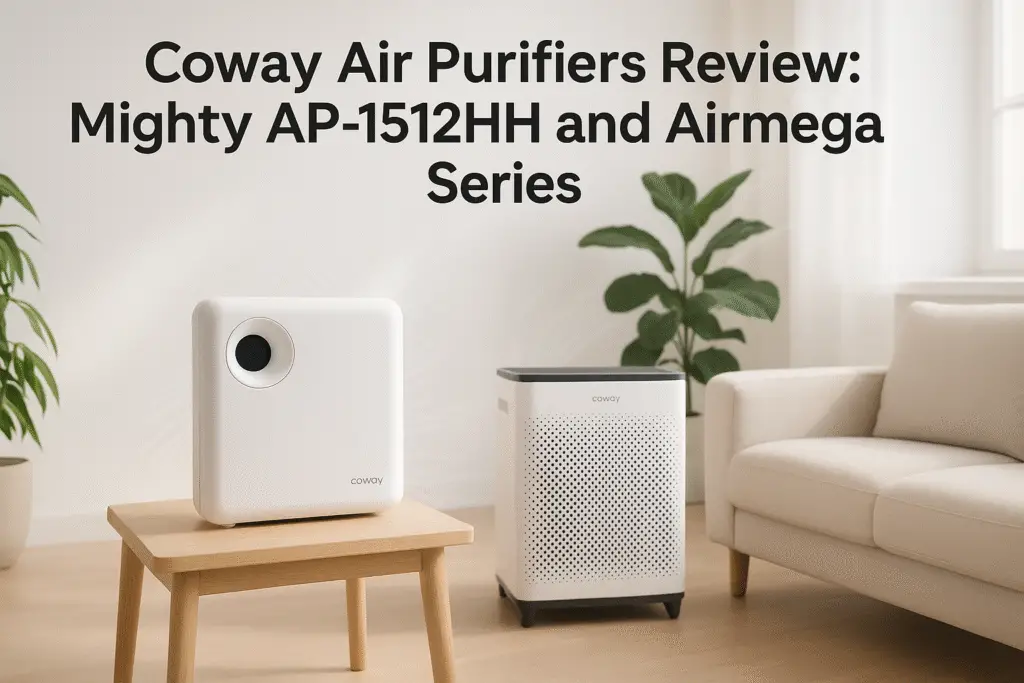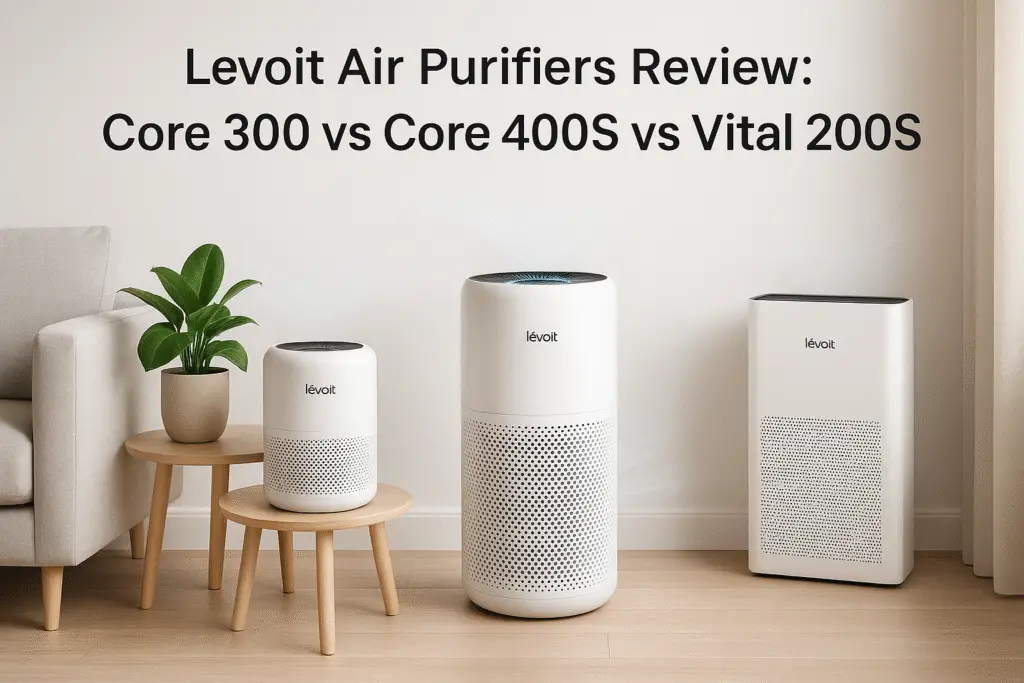Air purifiers have become essential home appliances, especially as we learn more about indoor air quality. Indoor air can contain 2-5 times more pollutants than outdoor air according to EPA research. When shopping for an air purifier, understanding technical specifications like room size compatibility, CADR ratings, filter types, and additional features is crucial for making an informed purchase. This comprehensive guide will walk you through everything you need to know to select the perfect air purifier for your specific needs.
Understanding Air Purifier Basics: How They Work and Why Specifications Matter
Before diving into technical specifications, it’s essential to understand the fundamental purpose of air purifiers and how different technologies address various air quality concerns.
Air purifiers work by cycling room air through a series of filters that trap or neutralize airborne contaminants. The purified air is then released back into the room, gradually improving overall air quality. This continuous air circulation process is what makes air purifiers effective at reducing indoor pollutants.
Most air purifiers use one or more of these filtration mechanisms:
- Mechanical filtration: Physically traps particles in filter material (like HEPA filters)
- Adsorption: Captures gases and odors through materials like activated carbon
- Electronic purification: Uses electrical charges to attract particles or break down contaminants
The effectiveness of an air purifier depends largely on how many times it can cycle all the air in a room each hour—known as air changes per hour (ACH). For general use, 2-3 ACH is acceptable, but people with allergies or respiratory conditions often need 4-5 ACH for better results.
Understanding these basics helps explain why technical specifications matter when choosing the right air purifier compared to other portable air cleaning solutions or HVAC filters.
Matching Air Purifier Size to Your Room: Square Footage, Ceiling Height, and CADR Explained
The most common mistake when purchasing an air purifier is choosing a model too small for your space. Here’s how to correctly match air purifier capacity to your room size.
CADR (Clean Air Delivery Rate) is the most reliable measurement of an air purifier’s cleaning power. Expressed in cubic feet per minute (CFM), CADR tells you how much filtered air an air purifier delivers. Higher CADR means faster and more efficient air cleaning.
To determine the right size air purifier, first measure your room’s square footage (length × width). Standard rooms have 8-foot ceilings, but if yours are higher, you’ll need to account for the additional volume.
For effective air cleaning:
- For general use: Choose a CADR rating that’s at least 2/3 of your room’s square footage
- For allergies/asthma: Choose a CADR rating equal to or greater than your room’s square footage
For example, a 300 square foot room would need an air purifier with a CADR of at least 200 for general use, or 300+ for allergy sufferers.
Manufacturer claims about room coverage often assume just 1-2 air changes per hour, which is insufficient for effective air cleaning. Use an air purifier room size calculator that factors in ACH (air changes per hour) to get a more accurate assessment of coverage capabilities.
Air Purifier Filter Types: HEPA, Activated Carbon, UV, and Ionizers Compared
Different air purifier filters target specific types of pollutants. Understanding which filters address your particular air quality concerns is crucial for making an effective purchase.
HEPA Filters: High-Efficiency Particulate Air filters are the gold standard for particle filtration. True HEPA filters capture 99.97% of particles as small as 0.3 microns, including dust, pollen, pet dander, and some bacteria. These filters excel at removing most airborne allergens.
Activated Carbon Filters: These work through adsorption, where gas molecules adhere to the carbon’s surface. They’re excellent for removing odors, smoke, volatile organic compounds (VOCs), and other gaseous pollutants that HEPA filters can’t capture. The effectiveness depends on the amount and quality of carbon used.
UV-C Light: Ultraviolet germicidal irradiation uses short-wavelength light to kill or inactivate microorganisms by destroying their DNA. UV-C is most effective against bacteria and viruses but requires sufficient exposure time and intensity to work properly.
Ionizers/Electronic Purifiers: These release negatively charged ions that attach to airborne particles, making them heavy enough to fall to the ground or stick to nearby surfaces. Some electronic purifiers can generate ozone, a lung irritant, so look for CARB-compliant models.
Photocatalytic Oxidation: This newer technology uses a catalyst (often titanium dioxide) activated by light to convert harmful pollutants into harmless substances. It’s effective against VOCs but varies in performance across different models.
Understanding True HEPA vs. HEPA-Type Filters
Not all HEPA filters are created equal. Understanding the difference between True HEPA and HEPA-type filters can significantly impact purification effectiveness.
True HEPA filters must meet strict certification standards, capturing 99.97% of particles at 0.3 microns. This specific size is the “most penetrating particle size” and is harder to capture than both larger and smaller particles.
HEPA-type or HEPA-like filters have no standardized requirements and typically capture 85-95% of particles at 0.3 microns. This seemingly small difference in efficiency can significantly impact air quality, especially for allergy and asthma sufferers.
For general household use with minimal allergies, HEPA-type filters may be sufficient. However, for households with allergy sufferers, pets, or respiratory conditions, investing in True HEPA filtration is worthwhile despite the higher cost.
Activated Carbon Filter Variations: Weight, Form, and Effectiveness
The effectiveness of activated carbon filters varies dramatically based on the amount and quality of carbon used – a factor rarely mentioned in marketing materials.
Carbon weight is the most important factor in effectiveness. Budget air purifiers might contain just a few ounces of carbon, while premium models can include 5+ pounds. More carbon means greater capacity to remove gases and odors and longer filter life.
Carbon form affects performance too:
- Granular carbon: Small carbon pieces with good adsorption but can create air channels that reduce effectiveness
- Honeycomb/structured carbon: Ensures even air distribution for more consistent performance
- Pelletized carbon: Compressed carbon with high density and greater adsorption capacity
Carbon filters are most effective against cooking odors, pet smells, smoke, and VOCs from cleaning products, paint, and new furniture. When your carbon filter stops removing odors effectively, it’s time for replacement—regardless of what indicator lights may show.
Decoding CADR Ratings: What the Numbers Mean for Real-World Performance
CADR (Clean Air Delivery Rate) is the most important specification for comparing air purifier performance, yet it’s often misunderstood or misrepresented. Here’s how to interpret these crucial numbers.
CADR measures how quickly an air purifier can remove specific pollutants from the air in cubic feet per minute (CFM). Higher numbers mean faster cleaning. Most air purifiers have three separate CADR ratings:
- Dust CADR: Effectiveness against particles 0.5-3 microns
- Pollen CADR: Effectiveness against particles 5-11 microns
- Smoke CADR: Effectiveness against particles 0.1-1 microns (smallest particles)
AHAM (Association of Home Appliance Manufacturers) certification ensures these ratings were determined through standardized testing. When comparing models, look for AHAM Verified labels for credible ratings.
For best results, match CADR ratings with your room size and required air changes per hour (ACH). For example, a 200 square foot room with 8-foot ceilings (1,600 cubic feet) would need a CADR of at least 107 for 4 air changes per hour.
Higher fan speeds increase CADR but also increase noise. When companies list only one CADR number, it’s typically the highest setting, which may be too loud for practical use.
Air Purifier Noise Levels: Understanding Decibel Ratings and Real-World Impact
Air purifier noise can significantly impact your comfort, especially in bedrooms or quiet spaces. Understanding noise ratings helps you select a model that balances performance with acoustic comfort.
Noise is typically measured in decibels (dB), with most air purifiers ranging from 30-60+ dB depending on fan speed:
- 30-40 dB: Whisper-quiet (like a library) – ideal for bedrooms and quiet spaces
- 40-50 dB: Soft background noise (like rainfall) – suitable for living rooms
- 50-60 dB: Conversation level – noticeable but not disruptive in active spaces
- 60+ dB: Vacuum cleaner level – potentially disruptive
Many air purifiers include sleep or night modes that reduce fan speed and noise levels. However, this reduction in fan speed also reduces CADR and cleaning effectiveness. The best bedroom air purifiers maintain reasonable filtration even at lower, quieter settings.
Sound quality matters too. Some purifiers produce a smooth white noise that many find soothing, while others create more mechanical or fluctuating sounds that can be distracting. Reviews often provide better insight into sound quality than specifications alone.
Energy Consumption and Operating Costs: Calculating the True Cost of Ownership
While purchase price is important, the total cost of owning an air purifier includes ongoing electricity and filter replacement expenses. Here’s how to calculate the true cost of ownership before making your decision.
Air purifier power consumption typically ranges from 5 watts (small, low-speed models) to 200+ watts (large, high-speed units). To calculate annual electricity costs:
- Multiply the wattage by hours used daily
- Multiply by 365 days
- Divide by 1000 to convert to kilowatt-hours (kWh)
- Multiply by your electricity rate (average US rate is about $0.14 per kWh)
For example, a 50-watt air purifier running 24 hours daily would cost about $61 per year in electricity (50W × 24h × 365 days ÷ 1000 × $0.14).
Filter replacement costs vary widely:
- HEPA filters: $20-100, typically replaced every 6-12 months
- Carbon filters: $25-200, typically replaced every 3-6 months
- Pre-filters: $10-30, typically replaced every 1-3 months or washable
A quality air purifier might cost $300 initially, but require $100-200 annually in filter replacements and electricity. Over 5 years, a $300 purifier could actually cost $800-1,300 total.
Energy Star certified models use at least 40% less energy than standard models, significantly reducing lifetime costs. Some smart features, like occupancy sensors that run the purifier only when needed, can further reduce operating costs.
Smart Features and Connectivity: Which Technological Advances Actually Matter
Modern air purifiers offer an array of smart features, from app control to air quality sensors. But which of these technologies provide genuine value versus marketing hype?
Air Quality Sensors: These can detect particles, VOCs, or both, and automatically adjust fan speed based on current air quality. Quality matters—budget models often have basic optical sensors that detect only larger particles, while premium models include laser particle counters and gas sensors for more accurate readings.
Auto Mode: This uses sensor data to adjust purification levels automatically. It’s most valuable in spaces with fluctuating pollution (kitchens, living areas) but less important in bedrooms where consistent operation is typically preferred.
Filter Life Indicators: Basic models use simple timers, while advanced models monitor actual airflow resistance to determine when filters need replacement. The latter provides more accurate maintenance timing and potential cost savings.
Smart Home Integration: Control via Alexa, Google Home, or Apple HomeKit can be convenient but rarely essential. Look for compatibility with Matter standard for better future-proofing.
Mobile Apps: Most valuable features include scheduling, remote operation, air quality history tracking, and filter replacement reminders. Apps with historical data can help identify pollution patterns and trigger sources in your home.
When deciding between a basic model and one with smart features, consider how the additional cost compares to the practical benefits for your specific needs and whether you’ll actually use these features long-term.
Optimal Air Purifier Placement: Location Strategies for Maximum Effectiveness
Even the most powerful air purifier will underperform if poorly positioned. These placement strategies can significantly improve air quality results regardless of which model you choose.
General Placement Principles:
- Position 3-5 feet off the ground for optimal air circulation
- Maintain at least 1-2 feet clearance from walls and furniture
- Place in areas with good airflow but not in direct path of fans or HVAC vents
- Keep intake and exhaust areas completely unobstructed
Room-Specific Recommendations:
- Bedrooms: Place 6-10 feet from your bed, not directly beside it
- Living rooms: Central location, away from curtains and upholstered furniture
- Kitchens: Away from direct heat and moisture, but close enough to capture cooking fumes
For specific pollutants, adjust placement accordingly. For pet allergies, place near areas where pets spend the most time. For cooking odors, position between the kitchen and adjacent living spaces to create a filtration boundary.
The most common placement mistake is hiding air purifiers behind furniture or in corners to keep them out of sight, which severely restricts airflow and effectiveness. If aesthetics are important, look for design-focused models rather than compromising placement.
Special Considerations: Allergies, Asthma, Pets, Smoke, and VOCs
Different air quality concerns require specific filtration approaches. Here’s how to select the right air purifier for your particular situation.
Allergies: Focus on True HEPA filtration with high CADR for your room size. Aim for 4-5 air changes per hour. Look for “Asthma & Allergy Friendly” certification from the Asthma and Allergy Foundation of America. Pre-filters that capture larger particles like pet hair and dust can extend the life of your main HEPA filter.
Asthma: Requires medical-grade filtration with True HEPA and minimal to no electronic ionization that might produce ozone. Look for models that have been clinically tested and certified for asthma relief. Consider purifiers with sealed systems that prevent air bypass around filters.
Pets: Require combination filtration—HEPA for dander and carbon for odors. The carbon filter should contain at least 1-2 pounds of activated carbon for effective odor control. Models with washable pre-filters help manage pet hair that would quickly clog main filters.
Wildfire Smoke: Focus on high smoke CADR ratings and substantial activated carbon filters (3+ pounds ideally). Look for models specifically tested for smoke removal. You’ll need higher air change rates (5+ ACH) during active smoke events.
Cooking Odors: Prioritize activated carbon weight and quality over HEPA specifications. Consider purifiers with specialized VOC removal capabilities, as cooking produces both particles and gases. Place units strategically to intercept cooking fumes before they spread throughout your home.
VOCs and Chemicals: Standard activated carbon may not be sufficient for severe chemical concerns. Look for specialized molecular adsorbents or catalytic oxidation technologies that target specific chemical compounds. Air quality monitoring capability is particularly valuable for VOC detection.
For homes with multiple concerns, prioritize based on health impact. Respiratory conditions generally warrant addressing particle filtration first, followed by gaseous pollutants and odors.
Understanding Air Purifier Certifications and Standards
Various certifications and standards can help verify an air purifier’s effectiveness and safety. Here’s what these credentials actually mean and which ones matter most.
AHAM Verified: The Association of Home Appliance Manufacturers tests and certifies CADR ratings through an independent process. This certification ensures the performance claims are legitimate and tested using standardized methods. Look for the AHAM Verified seal on the packaging or specification sheet.
Energy Star: Certified models are at least 40% more energy-efficient than standard models. This can significantly reduce long-term operating costs, especially for purifiers running 24/7.
CARB Compliance: The California Air Resources Board certifies that electronic air purifiers emit less than 0.05 parts per million of ozone. This is especially important for ionizers, electronic air purifiers, and UV systems.
True HEPA Certification: Ensures the filter removes 99.97% of particles at 0.3 microns. Without this specific certification, terms like “HEPA-type” may indicate lower filtration efficiency.
Asthma & Allergy Friendly: Products with this certification have been scientifically tested and proven effective at reducing exposure to asthma and allergy triggers.
When researching these certifications, verify claims through the certifying organization’s website rather than relying solely on manufacturer statements. Some companies display certification-like logos that aren’t from recognized testing organizations.
Air Purifier Maintenance: Filter Replacement, Cleaning, and Performance Monitoring
Proper maintenance is essential for ensuring your air purifier continues to perform effectively. These maintenance procedures will extend your purifier’s lifespan and maintain its efficiency.
Filter Replacement Schedules:
- Pre-filters: Clean or replace every 1-3 months
- Carbon filters: Replace every 3-6 months
- HEPA filters: Replace every 6-12 months
Filter lifespans vary based on air quality and usage. Signs that filters need replacement beyond indicator lights include decreased airflow, increased noise, noticeable odors, and visible dirt on HEPA filters.
When buying a new air purifier, consider looking at refurbished or used models with proper maintenance checks to save money while ensuring good performance.
For proper cleaning:
- Unplug the unit before any maintenance
- Vacuum exterior grills and intakes monthly with a brush attachment
- Wipe exterior surfaces with a damp microfiber cloth
- Never use water or cleaning products on HEPA or carbon filters
- Allow washable pre-filters to dry completely before reinstallation
To monitor performance, periodically check airflow from the output vent and listen for unusual noises that might indicate motor problems. Some smart models track performance metrics through their apps, providing early warning of reduced efficiency.
Keep replacement filters on hand to avoid gaps in protection, especially during high pollution seasons. During periods of heavy use, check pre-filters more frequently as they protect the more expensive main filters.
Frequently Asked Questions About Air Purifiers
Can air purifiers remove viruses and bacteria?
True HEPA filters can capture some viruses and bacteria (typically 0.1-0.3 microns), while UV-C light can inactivate those that are trapped. However, no air purifier can eliminate all airborne pathogens, and they should be considered just one part of a comprehensive approach to infection control.
Do air purifiers help with COVID-19?
According to the EPA and CDC, air purifiers with HEPA filtration can help reduce airborne transmission risk as part of a multi-layered approach that includes ventilation, masks, and social distancing. They cannot completely prevent transmission on their own.
How long should I run my air purifier each day?
For best results, run your air purifier 24/7, especially in bedrooms and frequently used spaces. At minimum, run it for 12 hours daily in rooms where you spend the most time. Intermittent use significantly reduces effectiveness.
Do air purifiers dry out the air?
No, air purifiers do not remove moisture from the air like dehumidifiers or air conditioners. They simply filter the existing air without affecting humidity levels.
Can air purifiers help with mold?
Air purifiers with HEPA filters can capture airborne mold spores but cannot address the source of mold or remove existing mold growth on surfaces. They should complement proper moisture control and mold remediation, not replace it.
During seasonal events like Diwali when air pollution spikes, air purifiers become especially important for maintaining indoor air quality.
Air Purifier Buying Guide: Final Recommendations and Checklist
With all these factors in mind, here’s a step-by-step approach to selecting the right air purifier for your specific needs.
Step 1: Identify Your Primary Air Quality Concerns
- Allergies and asthma
- Pet dander and odors
- Smoke (cooking, wildfire, tobacco)
- VOCs and chemical odors
- General air quality improvement
Step 2: Measure Your Room Size
- Calculate square footage (length × width)
- Note ceiling height if over 8 feet
- Consider using an online calculator to determine the right CADR and ACH for your room dimensions
Step 3: Determine Required Filtration Technology
- True HEPA for particles (allergies, dust, pollen)
- Activated carbon for odors and gases
- UV-C for germ concerns (optional)
- Consider filter replacement costs and availability
Step 4: Consider Practical Limitations
- Noise tolerance for your environment
- Available floor space for placement
- Energy costs and efficiency
- Budget constraints (both purchase and ongoing)
Step 5: Evaluate Additional Features
- Air quality sensors and auto mode
- Smart home integration if valuable to you
- Portability needs
- Design aesthetics for visible placement
When balancing budget considerations, remember that an air purifier is both a home appliance and a health investment. Focus on matching the right filtration technology to your specific air quality concerns rather than overpaying for features you won’t use. For those with specific holiday or gift needs, selecting an air purifier that balances budget with appropriate room coverage is essential.
The ideal air purifier combines effective filtration, appropriate sizing, reasonable noise levels, and manageable operating costs. By following this guide, you’ll be equipped to make an informed decision that truly improves your indoor air quality for years to come.
| Photo | Air Purifier Model | Best for | Price |
|---|---|---|---|

|
WINIX A231 Air Purifier | Asthma & Indoor Pollution | Check Price On Amazon |

|
Rabbit Air, A3 SPA-1000N Air Purifier | Pet Dander & Odors | Check Price On Amazon |

|
LEVOIT Air Purifier | Best Overall | Check Price On Amazon |

|
GermGuardian Air Purifier | Cigarette & Cooking Smoke | Check Price On Amazon |

|
Coway Airmega Air Purifier | New-borns | Check Price On Amazon |

|
BLUEAIR Air Purifier | Germ & Virus Control | Check Price On Amazon |
